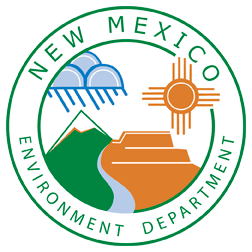Proposed Regulation of Firefighting Foams containing PFAS chemicals as hazardous wastes
During the 2025 legislative session, New Mexico amended the Hazardous Waste Act under House Bill 140 which, among other things, amends the definition of hazardous waste to include aqueous film-forming foam containing intentionally added PFAS. NMED HWB is currently preparing a proposed rule and petition to the Environmental Improvement Board (EIB) to propose revisions to the hazardous waste management regulations, 20.4.1 NMAC to specify new hazardous waste codes and other standards for regulated wastes.
For a brief description of these proposed changes, please see the fact sheet and other materials below:
Fact Sheet No 25-08 English
Fact Sheet No 25-08 Spanish
Public Notice No 25-08 English
Public Notice No 25-08 Spanish
HB140
Updates and technical corrections to the New Mexico Hazardous Waste Regulations requested by EPA
Periodically the New Mexico Environment Department coordinates with the Federal USEPA to ensure that NM’s Hazardous Waste regulatory Program is meeting federal standards. Following such a review, EPA officially renews the Authorization for a state that meets those standards to implement the hazardous waste program in lieu of the EPA. During review for New Mexico’s preparation to request re-authorization, NMED and EPA encountered certain provisions of the Hazardous Waste regulations that requires updates and corrections in order to properly delineate authorized state hazardous waste management oversight by NMED.
For a brief description of these proposed changes, please see the fact sheet and other materials below:
Fact Sheet No 25-07 English
Fact Sheet No 25-07 Spanish
Public Notice No 25-07 English
Public Notice No 25-07 Spanish
Compliance period for prospectively adopted hazardous waste regulations from 2019 through 2024 begins July 1, 2026
During changes promulgated by the NM Environmental Improvement Board during a 2019 rulemaking, New Mexico became one of a handful of states able to prospectively adopt the federal hazardous waste management regulations, meaning that more stringent requirements enacted by USEPA can become enforceable by NMED as soon as it is incorporated into the State’s Hazardous Waste Program. NMED is giving our businesses and other regulated entities some lead time to prepare for these changes to NMED’s Hazardous Waste Program and performing outreach to spread awareness. The compliance period for these provisions, including new regulatory exemptions and a new management structure for hazardous waste pharmaceuticals in New Mexico, begins July 1, 2026.
For a brief description of these proposed changes, please see the fact sheet and other materials below:
Fact Sheet No 25-06 English
Fact Sheet No 25-06 Spanish
Public Notice No 25-06 English
Public Notice No 25-06 Spanish
History of Proposed Regulations
Please see additional information on the 2019 proposed rules by clicking here.
Current Regulations
Hazardous Waste Management Regulations, 20.4.1 NMAC (12/1/2018)
Hazardous Waste Permit and Corrective Action Fee Regulations, 20.4.2 NMAC (Effective 3/5/2020)
Hazardous Waste Fee Regulations, 20.4.3 NMAC (Effective 3/5/2020)
Notification regarding check payments:
When you provide a check as payment, you authorize the State of New Mexico to either use information from your check to make a one-time electronic fund transfer from your account or to process the payment as a check transaction.
Disclosure Forms for Permitted Hazardous Waste Facilities
Federal Statute
The Solid Waste Disposal Act of 1965 [42 U.S.C. Section 6901 et seq.] commonly referred to as RCRA, or the Resource Conservation and Recovery Act was amended by Congress in 1976, it was also amended several more times, significantly by the Hazardous and Solid Waste Disposal Amendments (HSWA) of 1984 and the Federal Facilities Compliance Act (FFCO) of 1992. RCRA is the underlying law applied to solid waste, hazardous waste and underground storage tanks. RCRA provides the U.S. Environmental Protection Agency (EPA) the authority to oversee these activities. In turn, EPA authorizes states to provide equivalent coverage of RCRA.
EPA Authorization of State Rules
The State of New Mexico received authorization on January 25, 1985 from the U.S. Environmental Protection Agency (U.S. EPA) to implement its base hazardous waste management program. On January 2, 1996, New Mexico received authorization to implement HSWA corrective action. New Mexico received its most current authorization from the U.S. EPA on October 16, 2007.
States that receive final authorization from the U.S. EPA under RCRA section 3006(b), 42 U.S.C. 6926(b), must maintain a hazardous waste program that is equivalent to, consistent with, and no less stringent that the Federal Hazardous Waste Program. As the Federal program changes, states must change their programs and ask U.S. EPA to authorize the changes. Changes to state programs may be necessary when federal or state statutory or regulatory authority is modified or when certain other changes occur. Most commonly, states must change their program because of changes to U.S. EPA’s regulations in Title 40, Code of Federal Regulations (CFR) parts 124, 260-266, 268, 270, 273, 279 and 280.
Brief History of Statutes
Solid Waste Disposal Act of 1965
The Solid Waste Disposal Act of 1965 was the first federal effort to improve waste disposal technology. Its principal aim was regulation of municipal waste disposal technology, while recognizing that solid waste management was essentially a local issue. The Environmental Protection Agency was tasked with developing standards for waste disposal. Further, it was the intent of Congress that states and tribes be responsible for implementing and enforcing the regulations.
Resource Recovery Act of 1970 (RRA)
The Resource Recovery Act (RAA) was passed by congress with increasing concerns over protection of human health and the environment, as amendments to the 1965 Solid Waste Disposal Act. The RAA increased federal involvement with management of solid waste; it encouraged waste reduction and resource recovery and created national disposal criteria for hazardous wastes. This Act was the predecessor of the Resource Conservation and Recovery Act (RCRA) of 1976.
Resource Conservation and Recovery Act 1976 (RCRA)
The Resource Conservation and Recovery Act amended the Solid Waste Disposal Act and gave the U.S. Environmental Protection Agency the authority to control hazardous waste from “cradle-to-grave.” This includes the minimization, generation, transportation, treatment, storage, and disposal of hazardous waste. This is also known as RCRA Subtitle C. Other Subtitles of RCRA set forth a framework for the management of non-hazardous solid wastes. RCRA focuses on active and future facilities and does not address abandoned sites that are regulated under the Comprehensive Environmental Response, Compensation, and Liability Act (CERCLA) also known as Superfund.
New Mexico Hazardous Waste Act 1978
Hazardous and Solid Waste Amendments 1984 (HSWA)
On November 8, 1984, the Hazardous and Solid Waste Amendments amended RCRA and required phasing out land disposal of untreated hazardous waste by more stringent hazardous waste management standards (broken down into thirds with a time table for each third). Some of the other mandates of this law include increased enforcement authority for EPA and a program requiring corrective action.
Federal Facility Compliance Act 1992 (FFCA)
October 6, 1992, Congress passed the Federal Facilities Compliance Bill establishing a definition of “mixed waste” in the Federal Facilities Compliance Act [42 U.S.C. Section 6903; Public Law 102-386]. This act also clearly waives Department of Energy (DOE) and other Federal Facilities’ immunity from EPA and State hazardous waste regulations and sanctions and to also impose penalties for non-compliance. DOE is also required to develop a Site Treatment Plan (STP) for treatment of the hazardous components of radioactive wastes subject to RCRA requirements. Each DOE facility is required to establish an STP by October 6, 1995 to plan a compliance strategy.
Los Alamos National Laboratory and Sandia National Laboratories have effective FFCOs within New Mexico. The Los Alamos National Laboratory FFCO and the Sandia National Laboratories FFCO were issued on October 4, 1995.
Land Disposal Program Flexibility Act of 1996
This Land Disposal Program Flexibility Act of 1996 [Public Law 104-119] amended RCRA to provide regulatory flexibility for the land disposal of certain wastes. This act was passed by Congress in response to court challenges concerning implementation of the land disposal program under HSWA. This law applies less stringent land disposal standards to specific characteristic hazardous wastes that are managed at Clean Water Act or Safe Drinking Water Act facilities.
Federal Facility Compliance Act of 1992
Annual Environmental Improvement Board Hazardous Waste Fee Reports
2025 Annual Fee Report
2024 Annual Fee Report
2023 Annual Fee Report
2022 Annual Fee Report
2021 Annual Fee Report
2020 Annual Fee Report
2019 Annual Fee Report
2018 Annual Fee Report
2017 Annual Fee Report
2016 Annual Fee Report
2015 Annual Fee Report
2014 Annual Fee Report
2013 Annual Fee Report
2012 Annual Fee Report
2011 Annual Fee Report
2010 Annual Fee Report
2009 Annual Fee Report
2008 Annual Fee Report
2007 Annual Fee Report

